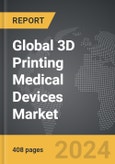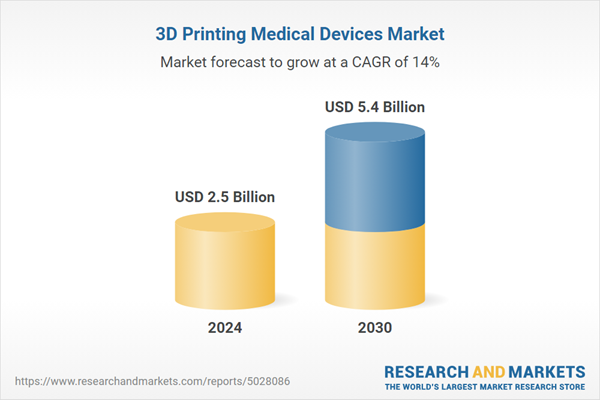Global 3D Printing Medical Devices Market - Key Trends & Drivers Summarized
3D printing, also known as additive manufacturing, has revolutionized the production of medical devices by enabling the creation of highly customized and complex products with unprecedented precision. This technology allows for layer-by-layer construction of devices from digital models, offering unparalleled design flexibility. In the medical field, 3D printing is used to produce a wide range of devices, including prosthetics, implants, surgical instruments, and anatomical models for pre-surgical planning. One of the key advantages of 3D printing in medical device manufacturing is the ability to tailor devices to the unique anatomy of individual patients, enhancing the fit and functionality of implants and prosthetics. This level of customization is particularly beneficial in orthopedics, dentistry, and craniofacial reconstruction, where patient-specific solutions can significantly improve clinical outcomes.The materials used in 3D printing medical devices vary widely, ranging from biocompatible plastics and metals to bioinks containing living cells. Polymers such as polylactic acid (PLA) and polyether ether ketone (PEEK) are commonly used for their biocompatibility and mechanical properties, making them suitable for a variety of medical applications. Metals like titanium and stainless steel are favored for their strength and durability, particularly in orthopedic implants. Recent advancements in bio-printing technology have also enabled the use of bioinks to print tissues and organs, paving the way for future innovations in regenerative medicine. This capability not only holds the promise of creating functional organ replacements but also facilitates drug testing and research by providing realistic models of human tissue. Advancements in 3D-printed skin, prosthetic bones and cartilages, and surgical equipment are giving a boost to the application of the technology in the medical sector.
The growth in the 3D printing medical devices market is driven by several factors. The increasing demand for personalized medical solutions is a major driver, as 3D printing technology allows for the efficient production of customized implants and prosthetics tailored to individual patient needs. Advances in 3D printing technology, including improvements in printer speed, precision, and material capabilities, have expanded the range of possible applications and increased the adoption of this technology in clinical settings. Additionally, the healthcare industry's push towards cost-effective and efficient manufacturing solutions aligns with the benefits of 3D printing, which can reduce waste and lower production costs. The regulatory environment is also evolving to support the use of 3D printed medical devices, with agencies like the FDA providing clear guidelines for the approval of these products. Furthermore, the ongoing research and development in bio-printing and tissue engineering are expected to unlock new possibilities in medical device manufacturing, driving further growth in the market. These factors, combined with the continuous innovation and integration of 3D printing technology in healthcare, are expected to sustain the rapid expansion of the 3D printing medical devices market in the coming years.
Report Scope
The report analyzes the 3D Printing Medical Devices market, presented in terms of market value (USD). The analysis covers the key segments and geographic regions outlined below.- Segments: Component (Systems, Materials, Services); Technology (Photopolymerization, Laser Beam Melting, Droplet Deposition, Electron Beam Melting (EBM), Other Technologies); End-Use (Medical & Surgical Centers, Pharma & Biotech Companies, Other End-Uses).
- Geographic Regions/Countries: World; USA; Canada; Japan; China; Europe; France; Germany; Italy; UK; Rest of Europe; Asia-Pacific; Rest of World.
Key Insights:
- Market Growth: Understand the significant growth trajectory of the Systems Component segment, which is expected to reach US$2.9 Billion by 2030 with a CAGR of 13.6%. The Materials Component segment is also set to grow at 15.3% CAGR over the analysis period.
- Regional Analysis: Gain insights into the U.S. market, valued at $805.5 Million in 2024, and China, forecasted to grow at an impressive 15% CAGR to reach $680.6 Million by 2030. Discover growth trends in other key regions, including Japan, Canada, Germany, and the Asia-Pacific.
Why You Should Buy This Report:
- Detailed Market Analysis: Access a thorough analysis of the Global 3D Printing Medical Devices Market, covering all major geographic regions and market segments.
- Competitive Insights: Get an overview of the competitive landscape, including the market presence of major players across different geographies.
- Future Trends and Drivers: Understand the key trends and drivers shaping the future of the Global 3D Printing Medical Devices Market.
- Actionable Insights: Benefit from actionable insights that can help you identify new revenue opportunities and make strategic business decisions.
Key Questions Answered:
- How is the Global 3D Printing Medical Devices Market expected to evolve by 2030?
- What are the main drivers and restraints affecting the market?
- Which market segments will grow the most over the forecast period?
- How will market shares for different regions and segments change by 2030?
- Who are the leading players in the market, and what are their prospects?
Report Features:
- Comprehensive Market Data: Independent analysis of annual sales and market forecasts in US$ Million from 2024 to 2030.
- In-Depth Regional Analysis: Detailed insights into key markets, including the U.S., China, Japan, Canada, Europe, Asia-Pacific, Latin America, Middle East, and Africa.
- Company Profiles: Coverage of players such as Autodesk, Inc., 3D Systems Inc. (USA), Exactech, Inc., Digilab, Inc., 3D Biotek, LLC and more.
- Complimentary Updates: Receive free report updates for one year to keep you informed of the latest market developments.
Some of the 93 companies featured in this 3D Printing Medical Devices market report include:
- Autodesk, Inc.
- 3D Systems Inc. (USA)
- Exactech, Inc.
- Digilab, Inc.
- 3D Biotek, LLC
- Aerotech, Inc.
- envisionTEC GmbH
- EOS GmbH
- Cyfuse Biomedical K.K.
- Esstech Inc.
- Arcam EBM, A GE Additive Company
- Advanced BioMatrix, Inc.
- Biogelx Ltd.
- 3T Additive Manufacturing Ltd.
- China Metallurgical Information and Standardization Institute (CMISI)
This edition integrates the latest global trade and economic shifts into comprehensive market analysis. Key updates include:
- Tariff and Trade Impact: Insights into global tariff negotiations across 180+ countries, with analysis of supply chain turbulence, sourcing disruptions, and geographic realignment. Special focus on 2025 as a pivotal year for trade tensions, including updated perspectives on the Trump-era tariffs.
- Adjusted Forecasts and Analytics: Revised global and regional market forecasts through 2030, incorporating tariff effects, economic uncertainty, and structural changes in globalization. Includes historical analysis from 2015 to 2023.
- Strategic Market Dynamics: Evaluation of revised market prospects, regional outlooks, and key economic indicators such as population and urbanization trends.
- Innovation & Technology Trends: Latest developments in product and process innovation, emerging technologies, and key industry drivers shaping the competitive landscape.
- Competitive Intelligence: Updated global market share estimates for 2025, competitive positioning of major players (Strong/Active/Niche/Trivial), and refined focus on leading global brands and core players.
- Expert Insight & Commentary: Strategic analysis from economists, trade experts, and domain specialists to contextualize market shifts and identify emerging opportunities.
Table of Contents
Companies Mentioned (Partial List)
A selection of companies mentioned in this report includes, but is not limited to:
- Autodesk, Inc.
- 3D Systems Inc. (USA)
- Exactech, Inc.
- Digilab, Inc.
- 3D Biotek, LLC
- Aerotech, Inc.
- envisionTEC GmbH
- EOS GmbH
- Cyfuse Biomedical K.K.
- Esstech Inc.
- Arcam EBM, A GE Additive Company
- Advanced BioMatrix, Inc.
- Biogelx Ltd.
- 3T Additive Manufacturing Ltd.
- China Metallurgical Information and Standardization Institute (CMISI)
Table Information
| Report Attribute | Details |
|---|---|
| No. of Pages | 408 |
| Published | December 2025 |
| Forecast Period | 2024 - 2030 |
| Estimated Market Value ( USD | $ 2.5 Billion |
| Forecasted Market Value ( USD | $ 5.4 Billion |
| Compound Annual Growth Rate | 14.0% |
| Regions Covered | Global |









